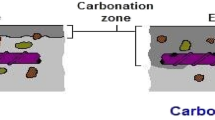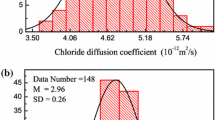Abstract
To show the application of the chloride conductivity index test in service life prediction (SLP) using both the deemed-to-satisfy and probabilistic approaches to performance-based durability design. It is desirable to adopt a performance-based approach with respect to durability design of reinforced concrete (RC) structures. This is based on the perception that the durability of RC is achieved when the limiting value from an established test method is met. In South Africa, the durability index (DI) approach has been developed, which permits performance-based specifications for durability of RC. This approach involves the application of a test method together with a SLP model. This integrated approach links material properties directly with the expected service life of RC structures and environmental conditions. Two DIs are relevant to degradation processes in RC: the chloride conductivity index which is related to chloride ingress, and the oxygen permeability index related to carbonation. The study presented here focuses on the application of the chloride conductivity index as the main input parameter of a SLP model concerned with chloride-induced reinforcement corrosion. The methodology and output of the SLP model as applied in the deemed-to-satisfy approach are compared with those of the probabilistic approach. Both approaches are exemplified using a concrete pier cast in situ in a marine environment. The performance-based durability specifications from the deemed-to-satisfy approach are found to be more conservative compared to those of the probabilistic approach.







Similar content being viewed by others
Abbreviations
- P f :
-
Probability of failure
- β target,ILS :
-
Target reliability at initiation limit state
- P target,ILS :
-
Limiting probability of failure at initiation limit state
- D i :
-
Diffusion coefficient (2-years)
- CCT:
-
Chloride conductivity test
- CDF:
-
Cumulative density function
- DI:
-
Durability index
- FORM:
-
First order reliability methods
- ILS:
-
Initiation limit state
- LSF:
-
Limit state function
- LSM:
-
Limit states method
- MCS:
-
Monte-Carlo simulation
- RC:
-
Reinforced concrete
- SLP:
-
Service life prediction
- SLS:
-
Serviceability limit state
- ULS:
-
Ultimate limit state
References
Alexander MG, Mackechnie JR (2003) Concrete mixes for durable marine structures. J S Afr Inst Civil Eng 45(2):20–25 ISSN: 1021-2019
Alexander MG, Mackechnie JR, Ballim Y (1999) Guide to the use of durability indexes for achieving durability in concrete structures. Research Monograph No 2, Department of Civil Engineering, University of Cape Town, Rondebosch, p 35
Alexander MG, Stanish K (2001) Durability design and specification of reinforced concrete structures using a multi-factor approach, Conference Proceedings in Honour of Sidney Mindess
Alexander MG, Ballim Y, Stanish K (2007) A framework for use of durability indexes in performance-based design and specifications for reinforced concrete structures. Mater Struct J 41(5):921–936. doi:10.1617/s11527-007-9295-0
Bijen, J. (1996) Blast furnace slag cement. Den Haag CIP Royal Library
Duracrete (2000) Statistical Quantification of the Variables in the Limit State Functions, The European Union—Brite EuRam III, Project BE95-1347/R9, Probabilistic Performance-Based Durability Design of Concrete Structures
EN 1990 (2000) Eurocode: basis of structural design. British Standards Institution
Faber MH, Sørensen JD (2002) Reliability based code calibration joint committee on structural safety. Paper for the Joint Committee on Structural Safety Draft
fib Bulletin no. 34 (2006). Model code for service life design, p 206, ISBN 978-2-88394-074-1
Gehlen C, Schiessl P (1999) 1999. Probability-based durability design for the Western-Scheldt Tunnel, Concrete Journal of the fib P1(2):1–7
Hasofer AM, Lind NC (1974) Exact and invariant second-moment code format. J Eng Mech Div, ASCE 100(1974):111–121
Holický M (2007) Probabilistic design of structures for durability, Proceedings of the SEMC Seminar
ISO 13823 (2008) General principles on the design of structures for durability, ISO TC98/SC2, Final draft
ISO 2394 (1998) General principles on reliability for structures for durability, p 73
Liu PL, Der Kiureghian A (1990) Optimization algorithms for structural reliability. Struct Saf 9(1990):161–177
Liu Y, Weyers RE (1998) Modelling the time-to-corrosion cracking in chloride contaminated reinforced concrete structures. Am Concr Inst Mater J 95(6):675–681
Mackechnie JR (1996) Prediction of reinforced concrete durability in the marine environment, PhD Thesis, University of Cape Town, Rondebosch
Mackechnie JR (1997) Prediction of reinforced concrete durability in the marine environment, Research Monograph No. 1, University of Cape Town, Rondebosch
Mackechnie JR (1998) Observations from case studies of marine concrete structures. SAICE J 40(4):29–32
Mackechnie JR, Alexander MG (1997) Durability findings from case studies of marine concrete structures. Cement, Concr Aggreg 19(1):22–25
Marchand J, Gernrd B, Delagrave A (1998) Ion transport mechanisms in cement-based materials. Mater Sci Concr 5(1998):307–400
Marteinsson B (2005) service life estimation in the design of buildings a development of the factor method, Doctoral Thesis, Department of Technology and Built Environment, University of Gävle, Sweden
Melchers RE (1999) Structural reliability analysis and prediction, Wiley, Chichester, –XVIII; 437 ISBN 0-471-98324-1
Muigai R (2008) Probabilistic modeling for durability design of reinforced concrete structures, MSc Thesis, University of Cape Town, Rondebosch
NordTest method (1995) NT build 443, Nordtest ISSN 0283—7153
Phoon KK, Kulhawy FH, Grigoriu MD (2000) Reliability-based design for transmission line foundations. Comput Geotech 26(3–4):169–185
Rackwitz R, Fiessler B (1978) Structural reliability under combined load sequences. Comput Struct 9(1978):489–494
Richardson MG (2002) Fundamentals of durable concrete, 1st edn. Spoon Press-Taylor and Francis group, London
Ronné PD (2005) Variation in cover to reinforcement: local and international trends, Concrete Beton, 111
Rostam S (2005) Service life design of concrete structures-a challenge to designers as well as to owners. Asian J Civil Eng (Build Hous) 6(5):423–445
SANS 10100-2 (2005) South African national standard: the structural use of concrete, Part 2: materials and execution work, 3rd edn, pp. 66
Sarja A, Vesikari E (1996) Durability design of concrete structures, 1st edn, Spon Press, London
Stanish K, Alexander MG, Ballim Y (2006) Assessing the repeatability and reproducibility of South African durability index tests. J S Afr Inst Civil Eng 48(2):10–17
Streicher PE (1997) The development of a rapid chloride test for concrete and its use in engineering practice, PhD Thesis, University of Cape Town, Rondebosch
Tang L, Nilsson LO (1992) Rapid determination of the chloride diffusivity in concrete by applying an electric field. Am Concr Inst Mater J 89(1):49–53
Zhang J, Lounis Z (2006) Sensitivity analysis of simplified diffusion-based corrosion initiation model of concrete structures exposed to chlorides. Cement Concr Res 36(7):1312–1323
Author information
Authors and Affiliations
Corresponding author
Rights and permissions
About this article
Cite this article
Muigai, R., Moyo, P. & Alexander, M. Durability design of reinforced concrete structures: a comparison of the use of durability indexes in the deemed-to-satisfy approach and the full-probabilistic approach. Mater Struct 45, 1233–1244 (2012). https://doi.org/10.1617/s11527-012-9829-y
Received:
Accepted:
Published:
Issue Date:
DOI: https://doi.org/10.1617/s11527-012-9829-y




